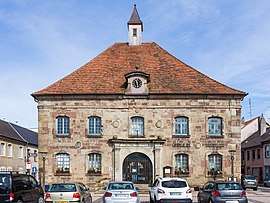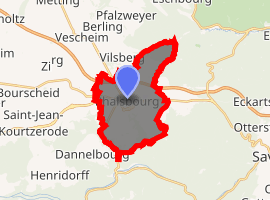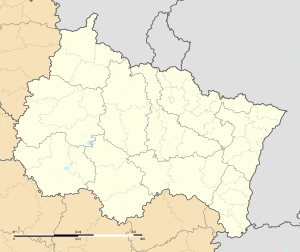Phalsbourg
Phalsbourg (German: Pfalzburg, Lorraine Franconian: Phalsburch) is a commune in the Moselle department in Grand Est in north-eastern France, with a population of about 5,000.
Phalsbourg | |
|---|---|
 Town hall of Phalsbourg, former Corps de Garde | |
 Coat of arms | |
Location of Phalsbourg 
| |
 Phalsbourg  Phalsbourg | |
| Coordinates: 48°46′N 7°16′E | |
| Country | France |
| Region | Grand Est |
| Department | Moselle |
| Arrondissement | Sarrebourg-Château-Salins |
| Canton | Phalsbourg |
| Government | |
| • Mayor (2008–2014) | Dany Kocher |
| Area 1 | 13.15 km2 (5.08 sq mi) |
| Population (2017-01-01)[1] | 4,728 |
| • Density | 360/km2 (930/sq mi) |
| Demonym(s) | phalsbourgeois |
| Time zone | UTC+01:00 (CET) |
| • Summer (DST) | UTC+02:00 (CEST) |
| INSEE/Postal code | 57540 /57370 |
| Elevation | 200–384 m (656–1,260 ft) (avg. 380 m or 1,250 ft) |
| Website | http://www.phalsbourg.com/ |
| 1 French Land Register data, which excludes lakes, ponds, glaciers > 1 km2 (0.386 sq mi or 247 acres) and river estuaries. | |
It lies high on the west slopes of the Vosges, 25 miles (40 km) northwest of Strasbourg by rail. In 1911, it contained an Evangelical and a Roman Catholic church, a synagogue and a teachers' seminary. Its industries then included the manufacture of gloves, straw hats and liqueurs, and quarrying.
History
The area of the city of Phalsbourg, originally Pfalzburg, was originally part of the principality of Lützelstein, under the overlordship of Luxembourg, then the bishops of Metz and of Strasbourg, before coming under the Dukes of Pfalz-Veldenz, all within the Holy Roman Empire of the German Nation. In 1570, Duke Georg Johann I of Pfalz-Veldenz founded the town of Pfalzburg as a refuge for Reformed Protestants kicked out of the Duchy of Lorraine, and as an administrative center of his holdings. But the cost forced him to sell the city and the surrounding district of Einarzhausen between 1583 and 1590 to Lorraine, whose territory surrounded most of the area. In 1608, his successor Georg Gustav of Pfalz-Veldenz founded nearby Lixheim for Reformed refugees, but was also forced to sell the new town in 1623 to Lorraine.
From 1629 to 1660, Pfalzburg and Lixheim were combined as the Principality of Pfalzburg, for duchess Henriette of Lorraine (1605-1660) and her three successive husbands. The principality was acknowledged by Holy Roman Emperor Ferdinand II in 1629. After the death of Henriette, the principality returned to Lorraine. But the next year, Lorraine had to cede it to France in the Treaty of Vincennes in 1661, at a time when most of Lorraine was occupied by French troops since 1634.
The famous French military engineer Vauban reconstructed the town's fortifications in 1680. The town was of military importance as commanding one of the passes of the Vosges. The fortifications of Phalsbourg resisted the Allies in 1814 and 1815, and the Germans for four months under the commander Taillant in 1870, but they were taken on 12 December of that year, and have since been razed. The town was German again from 1871 to 1918, under its old name of Pfalzburg.
The United States Air Forces in Europe built an air base near the city in 1953. The base was returned in 1967 to the French government, which redesignated it as Camp de la Horie. The base is currently used by the French military's 1er Régiment d'Hélicoptères de Combat.
Events
The town is home to the annual Erckmann-Chatrian summer festival. It is also the birthplace of Georges Mouton.
Climate
Climate in this area has mild differences between highs and lows, and there is adequate rainfall year-round. The Köppen Climate Classification subtype for this climate is "Cfb" (Marine West Coast Climate/Oceanic climate).[2]
See also
Notes
- "Populations légales 2017". INSEE. Retrieved 6 January 2020.
- Climate Summary for Phalsbourg
References
| Wikimedia Commons has media related to Phalsbourg. |

- Attribution
